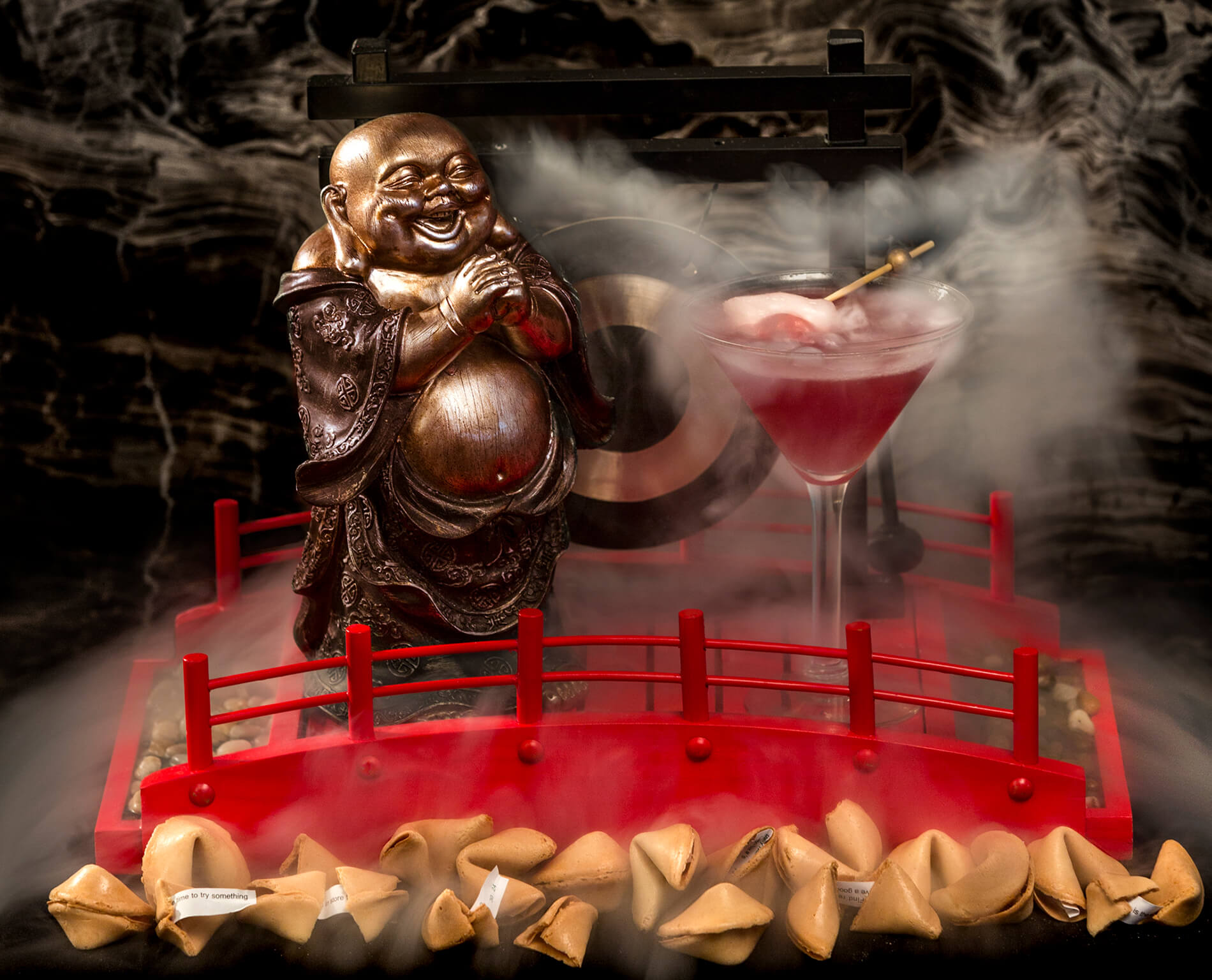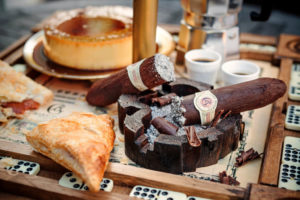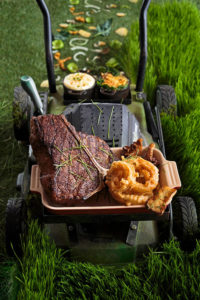The setting is elegant, all fine china and floor-length tablecloths. The guests are impeccably dressed. Then the meal arrives. The waiter serves the fillet of brook trout raw by dishing it out into a wooden box. After that, he fills the box with melted beeswax, until the fillet is completely covered. The fish cooks right there on the table for a while, until finally the waiter frees it from the now-hardened wax and wishes the table “Bon appetit.” The guests watch the procedure with interest, smiling, feeling entertained. That’s how Heinz Reitbauer, one of Austria’s top chefs, prepares brook trout at Steirereck in Vienna: no fireballs, no elaborate gimmickry, but he still puts on a show for his customers, while also making the cooking process more transparent.
It’s a particularly elegant form of tableside preparation, of which there are countless variations — some more creative than others, of course. The “classics” include carving larger cuts of meat, for example, or filleting fish. Fire obviously makes for a more dramatic presentation, whether you’re lighting up Crepes Suzette or flambeing an American dessert like Bananas Foster or Baked Alaska. Seasoning and serving Caesar salad or beef tartar from the serving cart, or Guéridon, is another common practice.
Tableside action is a longstanding tradition, one likely formally rooted in French culinary traditions. In the 19th century, as haute cuisine was coming into fashion among French nobility, Auguste Escoffier became one of the first chefs to attempt to formalize cooking methods in his “Guide Culinaire,” thus laying the foundations for classical French cuisine.

Image: Barton G.
One major change that came about as a result was a shift from service à la française (where everything was served at the same time) to service à la russe (where dishes were served as individual courses). Back then, food was prepared in the kitchen and then brought to the table on serving platters; either the waiter or the guest then portioned it out on to individual plates. The era of pompous service had arrived. It wasn’t until the nouvelle cuisine movement in the mid-20th century that waiters began plating food individually and bringing it out to guests already portioned. That allowed chefs to arrange food more artistically, and also meant restaurants could use less highly-trained serving staff. Nouvelle cuisine was designed to simplify the process, to allow diners to focus on attractive plating and fresh ingredients, rather than on the act of cooking itself.
Revival
After that, most restaurants did away with elaborate forms of service, which were seen as outdated and stodgy. A few highly traditional places still carved the occasional duck tableside or filleted a trout for a guest here and there, but that was about it.
Only in the past few years have modern chefs and restaurants rediscovered the art of tableside action. “A little theater always has its advantages,” says Daniel Humm, chef at Eleven Madison Park, which happens to be number four on the list of the World’s 50 Best Restaurants. “I love tableside preparation, because it brings back the showmanship, opulence, and elegance that have defined all my best dinner experiences.” The Swiss cook spent a long time trying to decide whether to prepare beef tartar in front of guests at Eleven Madison Park. After all, the dish is a well-established tradition in New York. But the classic version struck him as too uninteresting, so he serves a carrot tartar instead, for which service team members put carrots through a grinder tableside and plate them with eggs, onion, and peach puree.
Places on the other side of the ocean, including those without Michelin stars, are going back to the “old” ways, too. Meissl and Schadn, which recently reopened in Vienna, carves Martini-Gansl (St. Martin’s Day goose) once a year, and Tafelspitz (boiled beef fillet) all year round. “People want to see the quality of the ingredients with their own eyes,” says Culinary Director Jürgen Gschwendtner. Meissl and Schadn is based on the Habsburg restaurant of the same name, which was destroyed in 1945, and features traditional Viennese food in the style of the early 20th century — served the way it was back then. The Tafelspitz, for example, is served on a cart with a choice of six different cuts of meat. It’s not just about flashy presentation: “We want to keep this part of our cultural heritage alive,” Gschwendtner says. The Grill, opened by Major Food Group in New York last year, employs similar methods. There, waiters stride through the room in stylish Zac Posen suits, preparing Caesar salads and plating pasta à la presse on carts. Chef Mario Carbone wants to revive the fine-dining traditions of the 1950s—a golden age of tableside action.
Blinde taste tests
Christian Jürgens, the three-star chef at Überfahrt am Tegernsee, has watched the trend come and go. Three years ago, he was still cooking venison tableside over glowing coals. For another dish, he used a glass-flask machine to cook a soup in front of guests; the soup changed color during the process. “We were some of the first ones doing anything like that,” Jürgens says today. He served a variety of dishes tableside for around two years, but then he turned away from the method. “That was what I wanted to offer my guests back then, and I still stand behind those dishes a hundred percent and may end up serving them again in the future, but right now we’re going in a different direction,” Jürgens explains.
“I think tableside preparation needs to make sense—it can’t just be a gimmick. It’s only sensible if doing the dish tableside will mean better-quality results than if it were prepared in the kitchen.”
Those are among the main criticisms raised by many detractors of tableside action: many places just do it as a flashy gimmick, without regard for the fact that the food quality often suffers as a result. Caesar salad is prepared in front of guests so that the slightly cooked egg can be added to the dressing at the last possible moment, but if you’re making the dressing without eggs, there’s little point in doing it tableside.
Taste is what wins customers over, Jürgen says, not visuals. “In any dish, taste comes first, and everything else comes second,” he continues. “If a blind person came to my restaurant and told me afterward that the food was very good, that would probably be the highest compliment of all.”
Long live nitrogen
Of course, some chefs are all about spectacular service, and do it deliberately. Heston Blumenthal is a fierce advocate of multisensory cooking, arguing that eating is one of the few human experiences that involves all five senses. The British three-star chef takes pains to reflect that in his own cuisine. His bacon-and-eggs ice cream is one dish that’s made frequent headlines. To create it, he fries bacon and then soaks it in milk for several hours. That milk is then mixed with egg and sugar into a creme. The waiter at the Fat Duck heats the mixture in a pot tableside, then uses liquid nitrogen to cool it instantly to the consistency of ice cream. The dry-ice “smoke” billows out over the whole table, putting on a delightful show for the guests
Moderation
Steirereck in Vienna has been doing tableside preparations for years, but in moderation. The brook trout in beeswax is practically the only cooking done in front of guests, but there’s a separate bread cart, a honey cart, a cheese cart, and a cart of petit fours and citrus fruits from the orangery.
“These days, a lot is being asked of customers as it is,” says Birgit Reitbauer, hostess and wife of chef Heinz Reitbauer. “There’s no sense overwhelming them with all kinds of stimuli. Besides, elaborate service processes are only economically viable for restaurants that are of a certain size,” she points out. Over the years, tableside service has moved away from old standbys like flambeing and carving, and toward more creative alternatives. “It requires service staff to have more specialized knowledge. We often give long, precise explanations of the dishes, because customers are just more interested in knowing nowadays.” In general, she says, working tableside just comes with the territory, especially at Michelin-starred restaurants: “The more a waiter interacts with guests,” she says, “the better they understand our restaurant and our cuisine.” Ideally, she adds, that will make them more inclined to come back.
Carving
Carving meat into appropriate cuts and portion sizes requires a basic understanding of animal anatomy. It was part of standard training for pages (attendants to knights) in the Middle Ages, and is usually part of formal training for chefs and service professionals today. Dishes like Tafelspitz, turkey, and Peking duck are commonly carved tableside.
Plating from carts
Serving carts (Guéridons) are very common in most fine dining restaurants even today, and waiters traditionally use them to dish up classics like steak tartar, Caesar salad, and Crepes Suzette. In America, many restaurants also prepare guacamole tableside on a cart.
Filleting
Filleting whole fish tableside is a very popular practice. The waiter removes the skin and the bones and then serves only the fillet itself.


















